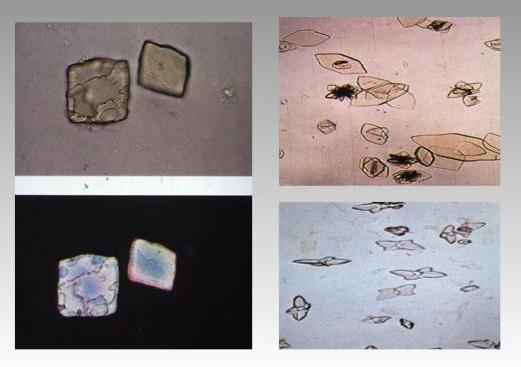
Kidneys are the organs responsible for the excretoryfunction of the body. Thanks to the work of these organs, all substances entering the bloodstream are filtered. They are responsible for maintaining water-salt and electrolyte exchange. In addition, they produce the hormone "erythropoietin", necessary to ensure the function of hematopoiesis. Evaluate the work of the kidneys by analyzing urine. There are many different laboratory methods for this study. In addition to the fact that the state of the isolated fluid can be known for the presence of inflammatory processes and impaired filtration capacity of the kidneys, sometimes crystals are found in the urine. In the norm they should not be. Therefore, the appearance of crystals in the analysis of urine testifies to functional disorders. In some cases, these changes are observed in the presence of stones. Sometimes this phenomenon indicates a predisposition to certain kidney diseases. In this case, the pathology itself may not yet develop.

Crystals are a collection of salts,forming a urinary sediment. Their appearance in small numbers is not always a deviation and is sometimes found in healthy people. If the crystals in the urine are significantly elevated, then this indicates a violation of the mineral metabolism. The following reasons for the appearance of salts in OAM are distinguished:
If, as a result of these reasons,amorphous crystals in the urine, this is not a pathological condition. Nevertheless, the constant consumption of a large number of products containing acids in food is considered a predisposing factor in the formation of kidney stones.

The crystals in the urine can be different. It depends on what salts they are formed from. The crystals are divided into phosphates, urates and calcium oxalates. Of all these substances, stones in the kidney or bladder can form. In some cases, concretions contain several different salts at once. Phosphates often precipitate in bladder infections (cystitis), and they also appear due to increased secretion of the parathyroid hormone. Urates are accumulations of salts of uric acid. Excessive development of this substance indicates a violation of mineral metabolism in the body (gout). In addition, urates are often present in the urine in chronic diseases of kidney tissue (nephritis, CRF). Most often, the stones consist of calcium, which is released in large quantities and forms crystals. Oxalates in urine are observed in diseases such as pyelonephritis and diabetes mellitus.

The presence of certain types of crystals is alwaysindicates a pathological condition. These include salts of gipuric acid, a cluster of cholesterol, bilirubin, leucine, tyrosine, hematoidin. Normally, these substances should not be excreted by the kidneys.
Most often, the presence of crystals in the urine does notis manifested. Especially if the accumulation of salts is present in a small amount. Symptoms occur with the formation of concrements and the development of urolithiasis. In this case, the work of the kidneys is disrupted due to obturation of the cup-and-pelvic system. Also, concrements can accumulate in the bladder and enter the ducts. As a consequence, there is a syndrome such as renal colic. The patient complains of severe pain in the lower back, giving down the abdomen and inguinal area. Due to the fact that there is a stone in the ureter, it is difficult to separate the fluid. Pain sensations in renal colic are so strong that the patient takes a forced position: on his side with the reduction of the legs to the abdomen. Crystals in the urine of a child are most often observed due to inflammatory pathologies (acute and chronic pyelonephritis, cystitis). Such ailments are accompanied by an increase in body temperature, nausea, pain in the waist and abdomen (more often on the one hand).

Urates, phosphates and crystals of calcium in the urineare detected by microscopic examination. In addition to OAM, a biochemical blood test is performed. The presence of crystals in the urine is indicated by the "+" sign. For example, the record "urata +++" means that these substances are present in large quantities. The pH is also determined. If this indicator is normal, conduct a more in-depth examination. Urinalysis is performed according to Zimnitskiy, Nechiporenko, renal ultrasound, excretory urography. In some cases it is necessary to conduct an examination of parathyroid glands. In addition to laboratory-instrumental diagnostics, it is necessary to find out what kind of food the person used before giving up the OAM, whether it drinks unfiltered water.
After clarifying the reason for the appearance of crystals inurine is prescribed treatment. If the kidneys have large stones, surgical intervention is required. In cases where crystals occur against a background of a disease (pyelonephritis, diabetes, gout), treatment should be directed to the underlying pathology. With the development of renal colic, antispasmodics are prescribed (tablets No-shpa, Drotaverin), uroseptics.

To prevent the formation of crystals inurinary sediment, it is necessary to periodically take out OAM. After all, often the accumulation of salts is not accompanied by any symptoms. It should be remembered that crystals are rarely formed with proper nutrition. Therefore, it is worth using products containing acids in limited quantities. It is not recommended to drink "raw" unfiltered water. In the presence of inflammatory and metabolic diseases it is necessary to fulfill the prescription of a doctor.
